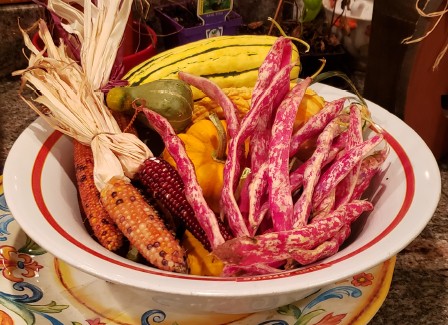As we approach Columbus Day and Indigenous Peoples Day, I’m continuing my series on foods that came from the “New World.” And today, I’m focusing on yet another plant crop that’s good for you and for the environment…
Beans!
Crops from the Americas add diversity to world’s nutrition
As I’ve explained before, Europe had just 16 different plants used as food sources up until the 1500s. So, nutritional status and cuisine on “the continent” was extremely limited.
Then came the age of exploration, whereby Europeans were introduced to the New World’s great bounty. Early explorers learned about “the three sisters”—which referred to beans, squash, and corn.
Native Americans planted these three crops alongside each other in the field because they worked so well together—both as a farming practice and nutritionally. The beanstalks grew up around the sturdier corn stalks. And the squash vines spread along the ground to keep out pests and to provide shade to the young squash blossoms and gourds.

We used this beautiful bounty from “the three sisters” to decorate a table at my daughter’s wedding this past September. My sister and I had visited a local farm the day before to pick the perfect the beans, corn, and squash for her traditional ceremony near historic Plymouth Rock.
Eventually, early colonists in North America adopted the practice too. In New England, the prepared dish became known as “succotash”—which some preferred pickled. (You can check out some of my favorite pickling recipes next month, in the November issue of Insiders’ Cures. So if you’re not yet a subscriber, now’s the perfect time to get started!) To this day, succotash is often found on traditional New England tables as a side dish or as relish.
By the 16th century, the common “green bean”—which botanists named Phaseolus vulgaris—had also begun to spread throughout Europe. And people began enjoying them in a variety of different ways.
For example, in Spain, they began to prepare beans with rice to create a nutritious meal that combined protein, carbohydrates, and essential amino acids.
This combination eventually diffused back to the Americas.
In fact, back in Cuba and on the islands of the Caribbean, black beans and rice became quite popular. They called it Moros y Christianos—a name that refers back to the early Spanish Conquistadors and their encounter with the Muslims on the Iberian Peninsula. On the mainland of the Americas, they made red beans and rice. And today, this combo is still quite popular in Mexican, Tex-Mex, and New Orleans style cooking.
The ancient Greeks and Romans had grown a different kind of bean called the Vigna sinensis. This bean came from Africa, and its name means, “Chinese beanstalk.” In Italy, they called it fagiolo dall’occhio or “bean with an eye,” as it has a unique black streak circling the hilum, or point of attachment to the pod. In the U.S. today, we call it a “black-eyed pea” or cowpea. How ironic that the one bean we typically associate with “down home,” American cooking did not originate in the Americas!
In all these places throughout history, beans served as a valuable food source because of their unique nutritional properties. Especially, in places where meat is scarce. Like meat, beans are relatively high in protein. Which is why we place beans (legumes called “pulses”) in a different category from grains or other plant-derived food sources. In addition, they contain carbohydrates, minerals, and electrolytes.
They also contain amino acids—thanks to their ability to host bacteria in their root nodules, which “fix nitrogen” in the soil. And this unique ability is also what makes them so good for the environment…
Beans are “nitrogen-fixing” crops
Remember, all crops deplete the soil’s nutrients. And corn, especially, uses a lot of nitrogen.
But beans—which are classified as legumes, like peas, peanuts, and lentils—take nitrogen from the air and put it back into the soil through their roots. (That’s another reason “the three sisters” worked so well to produce crops.). Some modern-day farmers plant beans for this very reason, as part of their sustainable crop rotation system.
Ancient farmers in China had learned about the effectiveness of crop rotation thousands of years ago. In fact, archaeologists think that over-cultivation of grains in ancient China quickly depleted the soil. Then, to improve soil conditions, farmers began to rotate grain crops with soybeans, which put nitrogen back into the soil.
At the same time, the people in China learned that soybeans need to be “processed” before eating to remove the “anti-trypsin” factors, which impair digestion. Typically, they boiled or roasted the soybeans with calcium or magnesium. The anti-trypsin poisons remained behind in the liquid, which they then discarded. Next, they pressed out the remaining water, which left the bean’s protein (or “meat”) as curd. To this day, people in China still use this traditional process to make tofu, soy sauce, and other foods.
Which brings me to another important point…
Occasionally eating unprocessed, whole soybeans—called edamame—won’t hurt you if you don’t make it a regular habit. But always make sure you buy organic edamame, as the vast majority of regular soybeans grown in this country are genetically modified (GM).
Of course, you can enjoy other types of beans in lots of different ways…
You can eat the whole pod, when it’s young and tender, as in green beans or string beans. In France, they call this type of bean mangetout or “eat everything.” In Italy, they call it cornetto or “little horn.”
You can also discard the outer shell and just eat the pods inside of the bean, as in black, cannellini, garbanzo, lentil, and kidney beans. Though remember—like soybeans, these types of beans may contain “anti-trypsin” factors, which can interfere with digestion, if not properly prepared.
So, always soak dried, mature beans for an extended period before cooking. This process rehydrates them. And it also helps leech out the factors that can cause indigestion.
